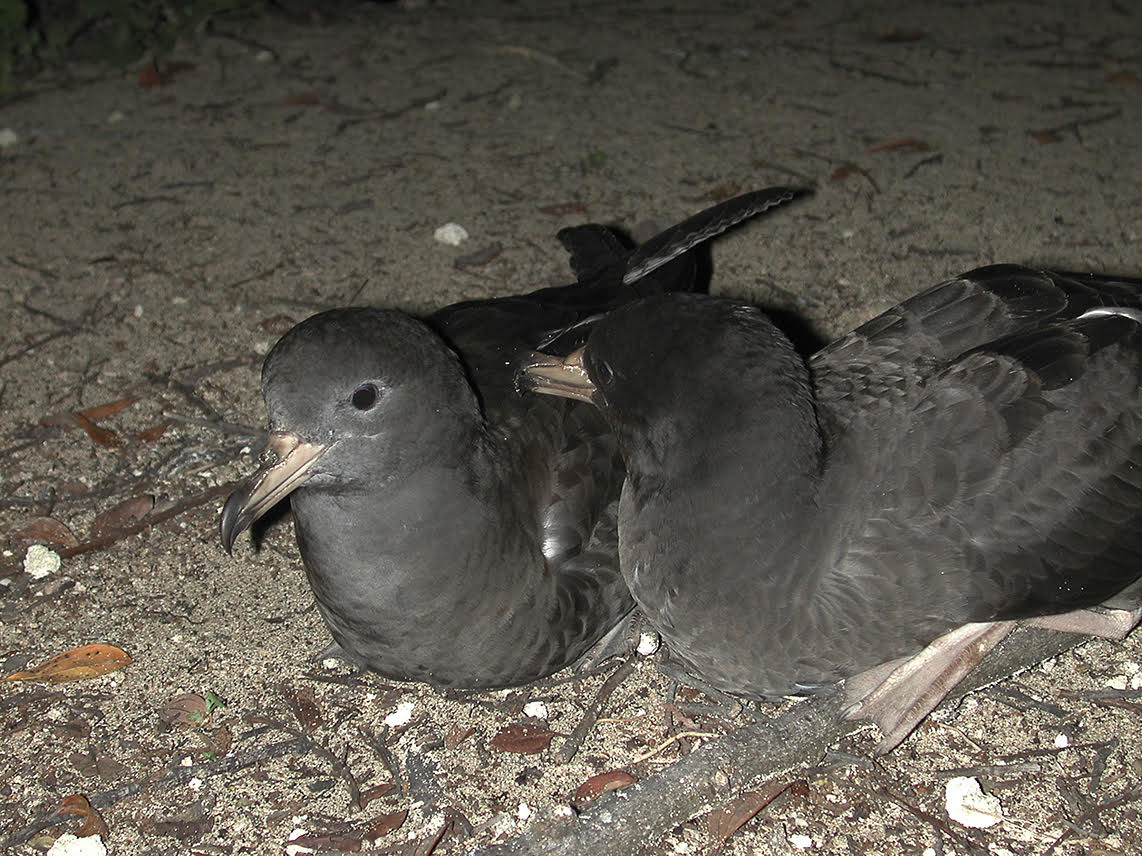Patrick Crowe and Mike Bell (Wildlife Management International, Blenheim, New Zealand) have presented a report on their research conducted on globally Near Threatened and Nationally Vulnerable Flesh-footed Shearwaters Ardenna carnepeis to New Zealand’s Department of Conservation (DOC) at a meeting of its Conservation Services Programme (CSP) Technical Working Group on 17 July this year (click here).

Flesh-footed Shearwaters, photograph by Ian Hatton
The report’s Executive Summary follows:
“This report covers the population monitoring of flesh-footed shearwaters (Puffinus carneipes) on Ohinau and Lady Alice Islands carried out under Conservation Services Programme project POP2018-04. It also covers two flesh-footed shearwater population estimates: Lady Alice Island and Motumahanga Island.
During the 2018/19 season we monitored 247 and 264 study burrows on Ohinau and Lady Alice Island respectively. The breeding success on Ohinau Island was 62%, down from 68% in the previous season. Breeding success on Lady Alice Island remained consistently low at 52%. There was no significant difference in breeding success between the two islands. Burrowscope (control) burrows, had a higher measured breeding success on both islands, however, the difference was again not statistically significant. We were able to identify both partners in 81% of burrows on Ohinau Island and 95% of burrows on Lady Alice Island. An additional 868 flesh-footed shearwaters were banded over both islands this season, including 453 chicks banded on Ohinau Island alone.
Burrow transects were carried out on Lady Alice Island to gather data for an updated population estimate for the island. 371 transects, each covering 40m², were completed within nine different colonies on the island. Occupancy rates varied greatly between colonies with the majority of flesh-footed shearwaters occupying burrows in colonies on the northern side of the island. Colonies to the east, west and south were either mixed-species colonies, or primarily grey-faced petrel colonies. We estimate that there are a total of 3217 occupied burrows (2180 – 4255, 95% CI) on Lady Alice Island.
A complete survey of burrows on Motumahanga Island revealed a total of 562 burrows occupied by flesh-footed shearwaters. This represents a significant increase from the 1989/90 estimate of just 100 burrows.”
The CSP monitors the impact of commercial fishing on protected species, studies species populations and looks at ways to limit bycatch. The programme is funded by levies from commercial fishers.
New Zealand has announced it is giving consideration to nominating the Flesh-footed Shearwater to the Agreement (click here).
Reference:
Crowe, P. & Bell, M. 2019. Flesh-footed Shearwater Population Monitoring and Estimates: 2018/19 Season. Blenheim: Wildlife Management International Ltd. 32 pp.
Earlier annual reports on this project:
Crowe, P. 2018. Flesh-footed Shearwater Population Monitoring on Ohinau and Lady Alice Islands, 2017/18 Report. Blenheim: Wildlife Management International Ltd. 23 pp.
Crowe, P., Bell, M., Kirk, H. & Burgin, D. 2017. Flesh-footed Shearwater Population Monitoring on Ohinau and Lady Alice Islands, 2016/17 Report. Blenheim: Wildlife Management International Ltd. 20 pp.
To access more reports to DOC on the Flesh-footed Shearwater in New Zealand click here.
John Cooper ACAP Information Officer, 22 July 2019

 English
English  Français
Français  Español
Español